Combat aircraft. "Flying shoe" for Cinderella the mermaid
As I have written many times, there are airplanes and there are airplanes. Some are simply masterpieces, while others look like a genetic error in the design statement. This is normal. Today, fortunately, one of the best and most beautiful representatives of the flying boat class, the brainchild of Blom & Foss, BV.138.
For some reason, the plane-boat did not receive an official name, and the “people's” name was quite apt. Der fliegenderholz Schuh - Flying Wooden Shoe. Yes, the klump, a German wooden shoe, in which peasants easily walked even in the 20th century, is very similar.
Hamburger Flyugzeugbau (the Blom & Foss aircraft division) have always taken the construction of seaplanes seriously. But with this model, they generally went beyond the line and created a flying boat of a unique design, which later became a classic.
In general, the German Navy needed a more or less decent long-range reconnaissance officer. What the Entente allies allowed the Germans to leave in this regard was gradually being scrapped. And as soon as Hitler came to power, Blom and Foss was offered to work on such an aircraft.
In 1934, the designers of Richard Vogt, the chief designer of the Hamburger Flyugtsoygbau, who were enraged by forced idleness, submitted for consideration THREE versions of a long-range reconnaissance-flying boat.
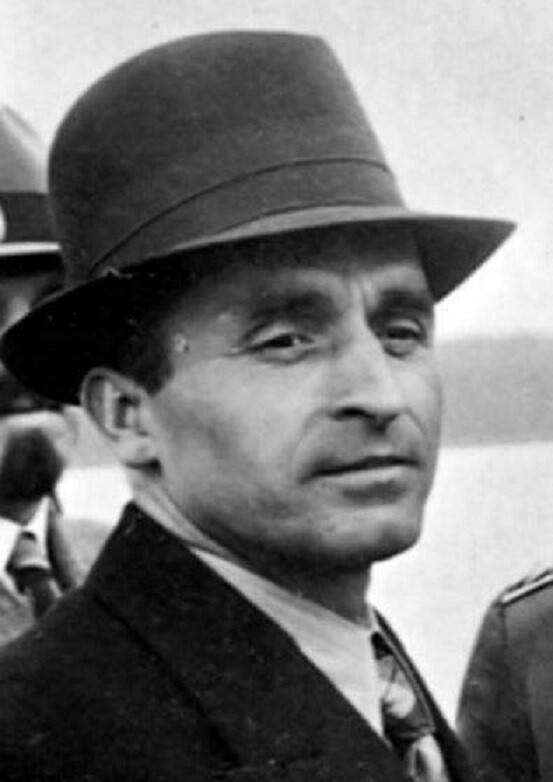
Richard Vogt
"Project 8". A very original model, with a short boat hull, tail unit on extended beams and a "gull" wing with a span of 25 m and two VMW-XV engines.
"Project 12". Classic boat hull, normal wing with a span of 27 meters, three Junkers Jumo-205 engines.
"Project 13". Wing from "Project 12", catamaran scheme and four Jumo-205 engines.
In the end, the technical department did not like any of the projects. However, it was decided to finalize the "Project 8", as it had a perspective. So it was proposed to enlarge "Project 8" to the size of "Project 12" and equip it with other engines. By that time, it became clear that the BMW-XV would not go into series production, so development for other engines was needed.
Vogt decided not to waste time on trifles and again made all the estimates with a large margin. On the boat, which by that time had received the name Na.138, it was proposed to install either two aviation diesel Jumo-206, or three Jumo-205, and as an alternative to Junkers - two Daimler-Benz DB-600.
And unhurried (due to low priority) work on the plane began. As the first examples of the boat were being built, the Jumo-206 engine "fell off". By that time, Heinkel and Messerschmitt were seriously fighting for the DB-600, so Vogt had no choice but to install three Jumo-205 engines on the plane. The two engines were frankly weak, but no one claimed for them in large volumes.
The first Hа.138-V1 flew on July 15, 1937. Four weeks later the second plane also flew. The flights showed that the aircraft needed to be improved: the hydrodynamic qualities of the short hull turned out to be unexpectedly low. The plane was very unstable at liftoff and climb. I had to redo the tail unit and increase its size.
So the plane got to the final tests only in November 1937. The tests were carried out in the Baltic, let's say, not at the best time of the year for this. But tests in conditions close to combat showed that the plane is very far from perfect.
The hull contours were not very successful, the boat's hull required reinforcement, and the tail booms tended to vibrate. In addition, it turned out that the cockpit equipment was completely unsuitable for long-distance flights.
As a result, the plane was really seriously altered. Almost nothing remained of the original configuration. The hull was redesigned, its length increased from 12,2 m to 15,15 m. Redan was moved forward, the contours were completely redesigned. Added power steering.
And we got the plane that we see in the photo.
Engines - three diesel Jumo-205C-4. One engine was mounted on a pylon above the fuselage, the other two in gondolas, in continuation of the tail booms. Propellers - three-bladed, variable pitch.
The normal composition of the crew is 5 people. The cockpit had dual controls. In the central section there was a radio compartment, a kitchen, a recreation room with three bunks.
Since this was planned as a scout, the designers took care of the defensive armament.
In the bow, just below the cockpit, a hydraulically controlled LВ-204 turret with a 20-mm MG-204 cannon was placed.
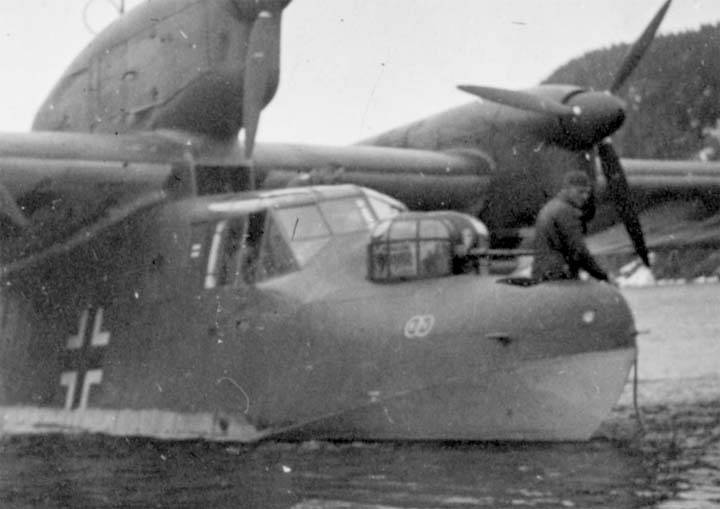
This rather rare cannon was created on the basis of the S-18-350 product of the Swiss company Waffenfabrik Soloturn AG. It was very advanced weapon... The gun fired shells 20 x 105 weighing 134 g (high-explosive) and 140 g (armor-piercing) with a combat rate of up to 500 rounds per minute with an initial speed of 826 m / s. The gun's only drawback was the 20-round magazine. But in general, the MG-204 was head and shoulders above the main cannon of the Luftwaffe MG-FF.
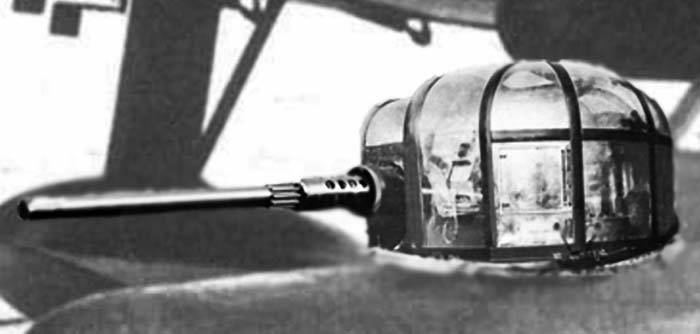
The cannon could work quite successfully both on enemy aircraft in the bow sector, and on lightly armored ships or submarines. The power of the projectile allowed. Ammunition consisted of 5 stores
There were two machine-gun points behind the wing. Two MG.15 machine guns were installed behind the middle engine nacelle and at the end of the hull, which could fire above and below the stabilizer, respectively.
The armament of the aircraft was completed by three bomb racks for bombs weighing up to 50 kg.
The first copy of the new aircraft ВV.138a-1 flew in February 1939. The flights were very encouraging and the Ministry of Aviation issued an order for 5 pre-production aircraft ВV.138a-1 and 25 production aircraft ВV.138b-0.
With the test of the pre-production BV.138a-1, it turned out in a peculiar way: while they were waiting for the ice drift on the Elbe, in April 1940 the German invasion of Denmark and Norway began. And then seaplanes were needed, which, of course, were not enough. Therefore, pre-production copies were urgently transferred to units that took part in operations in the north, where the tests went in a really combat mode.
The first two BV.138a-1 carried out transport operations to Stavanger, Andalsnes, Trondheim and Bodo. The next ten aircraft from Hamburg were ferried to the base in Travemünde, flew around there quickly and immediately went into action.
Not to say that everything went like clockwork. The very delicate diesel engines Jumo-205C-4, which required well-prepared hands, drank a lot of blood. But most of the problems arose with the tower installation in the nose. The tower mechanics turned out to be very unreliable and constantly wedged. There were also problems with hydraulics. The MG-204 cannon caused a lot of criticism. Reloading heavy drums in flight was very difficult, and the gun's automatic equipment allowed delays.
As a result, it became clear that in order for the BV.138 to become an aircraft with a capital letter, a new engine and a new cannon in a new turret were needed.
The use of BV.138 was limited until the remaining identified deficiencies were corrected. For the sake of fairness, it should be noted that in the modification BV.138b-1, most of the problems were solved.
The Jumo-205C-4 was replaced by a newer and more powerful Jumo-205D with a capacity of 880 hp. A new turret was developed and installed for the new MG-151/20 cannon.
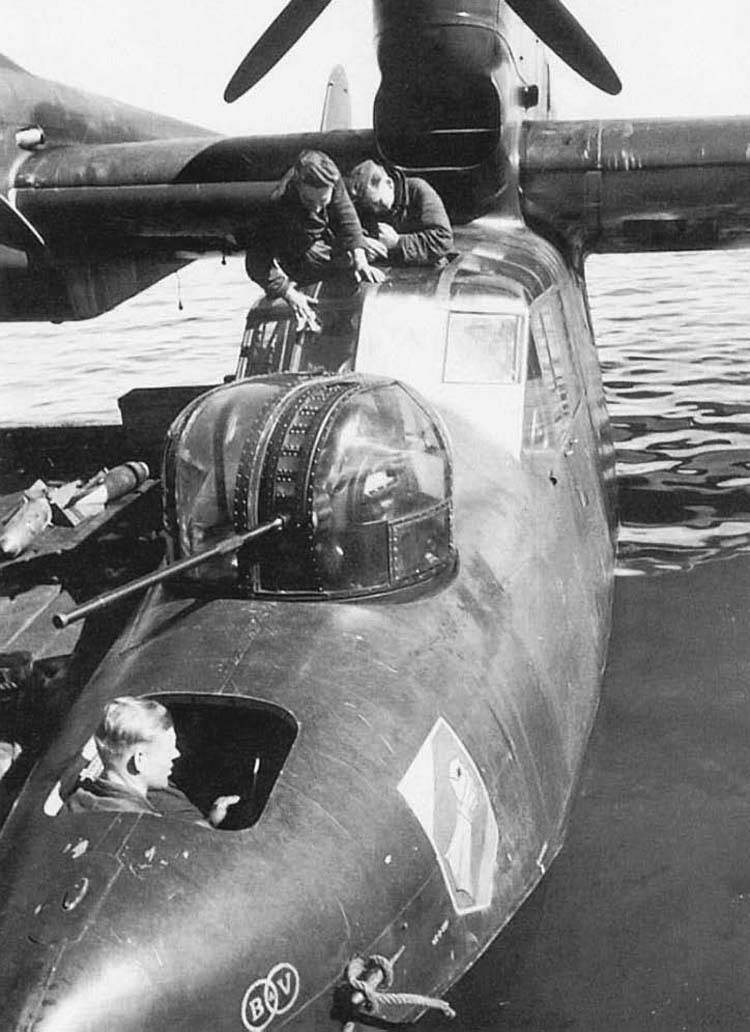
Being positive about the results shown by the new cannon, the Ministry of Aviation decided that the second cannon in the tail section of the aircraft would not be superfluous. The MG.15 machine gun was left behind the engine. In addition, BV.138b-1 received the ability to hang up to six bombs weighing 50 kg or three 150-kg depth charges.
Almost simultaneously, Blom and Foss launched the third modification, BV.138c-1. It differed from the previous one by a reinforced body and a large total weight. Instead of MG.15, a large-caliber MG.131 machine gun was installed, and MG.15 was given to the radio operator, who, if necessary, could fire from it on the starboard side through his window. Such a one-sided increase in protection.
Have not forgotten about the firstborn. In 1941, all BV.138a were recalled to Hamburg for modernization to the level of BV.138s-1.
The total output of ВV.138c was 227 vehicles.
As part of the upgrades, 70 vehicles received components for launching from a catapult. These aircraft were used on the Ostmark type aircrafts, ships equipped with a catapult and a hydraulic crane. This set made it possible to operate aircraft at a considerable distance from the bases, for example, in the polar regions.
In general, as soon as the "childhood illnesses" of the BV.138 were resolved, the aircraft proved to be more and more effective. As a patrol plane, he was simply gorgeous. The seaworthiness improved so much that they began to allow the aircraft to be used on the high seas.
For the crews of BV.138, a simply unique tactic of hunting from an ambush was developed. BV.138 flew to a certain area of the Atlantic, landed on the water and drifted quietly for a couple of days. In case of receiving news that the enemy convoy was somewhere nearby, BV.138 took off from the surface, spotted the convoy and directed submarines and long-range aircraft by radio (FW.200 Condor). And he could attack himself, fortunately, there was something.
Three firing points (two of them cannon), with good sectors of fire - the plane was very toothy. The firing range of the cannons provided effective defense, and in terms of attacking an unarmored ship, things could be done. The crew was increased to 6 people, but usually consisted of five.
So the appearance of this flying boat with an easily recognizable "shoe" profile, to put it mildly, was not welcomed by the crews of the Atlantic convoys. And if it was welcomed, then from all the trunks.
By the way, even the knocked-out and damaged ВV.138 had the opportunity to leave, sit on the water and make initial repairs by the crew. Access to all units and mechanisms was maximally facilitated at the design stage.
Much attention was paid to the possibility of servicing the aircraft by the crew away from the base so that even rather complex repairs could be carried out on the high seas.
With a maximum fuel supply, VV.138c-1 could stay in the air for up to 18 hours, although with a normal one about 7. With a normal takeoff weight of 14500 kg and calm water, the takeoff run lasted 30 seconds and was 700 m. The takeoff speed was 108 km / h, landing - 114 km / h.
With the outbreak of war, the Technical Department of the Ministry of Aviation began to think about replacing the BV.138 with something more perfect. The non-competitive contract was proposed by Blom & Foss. The next aircraft was supposed to have a takeoff weight of about 24 tons, that is, to be an enlarged version of the BV.138. The boat was supposed to take on board 60 paratroopers in full gear or 2 kg of bombs.
Blom & Foss proposed eight projects. The basis of these aircraft was to be a new Junkers engine, a Jumo-208 diesel with a capacity of 1100 hp.
"Project-110" - an enlarged version of VV.138 for three engines;
"Project-111" - asymmetrical, three-engine version "110";
"Project-112" - asymmetrical, three-engine, with an enlarged body;
"Project-113" - a three-engine, double-hulled boat with dimensions and weight of "112";
"Project-122" - four-engine, two-girder;
"Project-123" - the double-hull equivalent of "122";
"Project-124" - identical to "122", but had a retractable landing gear;
"Project-125" - variant "123", but the hull was increased.
Alas, all these projects remained in the drawings. Jumo-208 engines did not go into production, there were simply no other engines. Therefore, BV.138 remained to fight until the end of the war.
And the boats "Blom and Foss" fought in absolutely all theaters of war. The French coast of the Atlantic, bases in Troms, Trondheim and Stavanger, in the Baltic, Constanta on the Black Sea - the geography is quite wide.
During October 1941, one squadron with BV.138b-1, having 10 aircraft, flew more than 500 hours in long-range reconnaissance flights, covering 10 km. This is a very decent indicator, which immediately dismissed all speculation about the unreliability of the BV.000 flying boats.
And in terms of combat, BV.138 was quite up to par. In the Norwegian campaign, the flying boat included the heavy fighter Blenheim, which was shot down over the Skagerrak, and the Catalina, which was shot down over the North Sea.
Based on Constanta, under the cover of Romanian fighters, BV.138 operated in the Black Sea until the summer of 1944. They mainly conducted reconnaissance and bombed ships.
In the northern theater, in the Arctic, in the north of Norway, a whole squadron was based - 44 ВV.138. They provided detection and tracking of convoys. And on September 8, 1942, it was BV.138, which departed from Tromsø, found the convoy PQ-18 off Jan Mayen Island. BV.138 began to accompany the convoy, but the next day the escort ships arrived, which included the escort aircraft carrier Avenger with 12 Sea Hurricane fighters. This was the first time that a convoy was constantly moving with air cover.
Of course, this squadron of British fighters could not repel the raid of the torpedo squadron, but it was easy to complicate the actions of the scout. One of the BV.138 had an hour and a half battle with fighters. VV.138 returned to the base, but with very serious damage.
In general, BV.138, operating from bases in Norway, practically controlled all the northern routes. Diesel engines of the flying boat made it possible to refuel from submarine fuel tanks and continue flights.
For ice reconnaissance in the Kara Sea and the detection of convoys, German submariners even organized a supply base on Novaya Zemlya. In general, on Soviet territory. And from the island BV.138 flew east to the Yamal Peninsula in the east and to the northern part of the Urals. A total of 8 reconnaissance flights were carried out. Not much, but the question is what intelligence was obtained.
By the summer of 1944, the number of ВV.138 in units had decreased markedly. Still, the flying boat, not very fast in the air, was doomed in the face of the enemy's overwhelming advantage in the air. So the only place where BV.138 served until the very end of the war was in the northern waters, where boats operated from bases in Norway.
Separately, it is worth saying a few words about the trawl modification BV.138. In the second half of the war, many countries mastered the technology of producing magnetic mines on a massive scale. And magnetic mines began to be installed by everyone who had such an opportunity. Accordingly, these mines had to be dealt with somehow.
We will not go into the specifics of the operation of magnetic mines, we will only say that an aircraft equipped with appropriate equipment that simulates the magnetic field of a ship could cause such a mine to detonate, already at a safe distance.
Either a ring or a magnetic cable was used to detonate magnetic mines. The Germans used several types of aircraft for this activity, including the BV.138.
A small number of ВV.138 were converted into minesweepers, since many minesweepers were not required. The minesweeper-flying boat received the designation ВV.138-MS. The aircraft was used to sweep magnetic mines on canals, rivers and along the coastline.
All weapons were removed from the BV.138-MS, except for the 13-mm machine gun. Filmed tanks for fuel and oil, bomb racks, boxes for ammunition - everything that could lighten the boat.
The total weight of the elements required to convert a flying boat into an aircraft for the destruction of minefields was 1136,4 kg. The magnetic ring for detonating mines had an average diameter of 14,07 meters.
A separate diesel generator, required to use the magnetic ring, was installed in the fuselage. That's almost 1200 kg more, including 120 kg of fuel needed to run the generator for four hours. The hull of the boat had to be further strengthened, since such a weight could not be in vain.
The weight of the BV 138 MS with a magnetic ring and the equipment necessary for initiating magnetic mines was 16 tons, the fuel supply was 1 liters. At a cruising speed of 725 km / h, the flight duration was 200 hours.
Six BV.138-MS minesweepers converted in this way operated in the 1st regiment of mine seekers.
By the time the Great Patriotic War ended, with the end of which Germany's participation in World War II ended, BV.138 practically disappeared from the Luftwaffe. Only a few copies remained.
The last use of BV.138 occurred on the night of May 1, 1945. The aircraft, commanded by Chief Lieutenant Wolfgang Klemusch from 3. (F) / SAGr. 130, based in Copenhagen, was ordered to fly in his BV.138 to Berlin at night, land on the lake and pick up two very important couriers.
Despite the fact that the Soviet units fired intensively, Klemush successfully landed. However, there was a discrepancy with the couriers. Since they could not provide documents that it was they who were carrying out the mission, of which Klemush was a participant, the chief lieutenant did not bother himself with these very important persons, but loaded 10 wounded on board his boat and flew back to Copenhagen.
They say that these couriers were supposed to deliver to the port of Flensburg in northern Germany, where the headquarters of Grand Admiral Karl Doenitz, who was appointed Hitler's successor, was located, the will and the last will of Hitler himself.
All in all, the creation of BV.138 is a great page in stories Blom & Foss. Interesting, reliable and useful aircraft, which really is one of the best representatives of naval aviation.
LTH BV.138c-1
Wingspan, m: 26,95
Length, m: 19,85
Height, m: 5,90
Wing area, м2: 108,50
Weight, kg
- empty aircraft: 11 780
- normal takeoff: 14 513
- maximum take-off: 17 666
Engines: 3 x Junkers Jumo-205D x 880 hp
Maximum speed km / h: 283
Cruising speed, km / h: 234
Practical range, km
- maximum: 4 272
- normal: 1 212
Maximum rate of climb, m / min: 135
Practical ceiling, m: 5 000
Crew, prs: 6
Armament:
- two 20 mm MG-151 cannon in the bow and stern turrets
- 13 mm MG-131 machine gun on the pylon of the central engine
- 3 x 50-kg bombs under the right center section or
- 6 x 50-kg bombs or 3 x 150-kg depth charges in the U1 version.
A total of 297 BV.138 flying boats of all modifications were built.
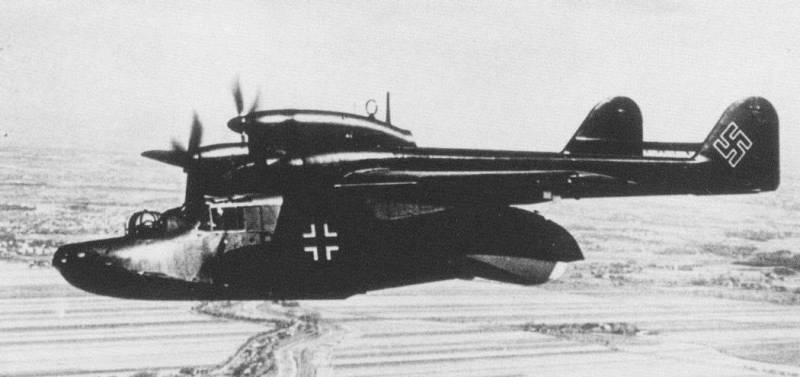

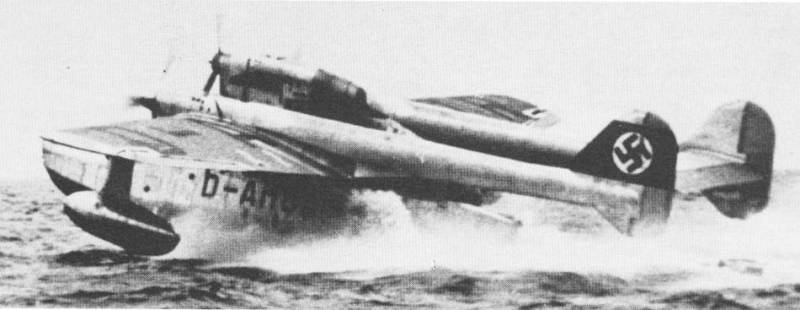
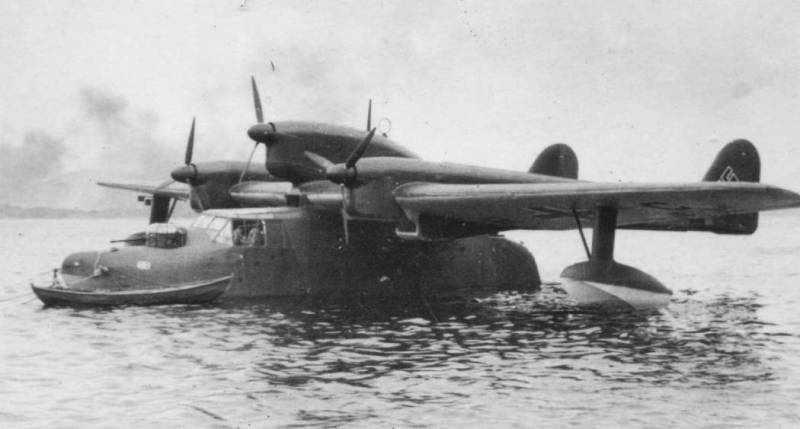
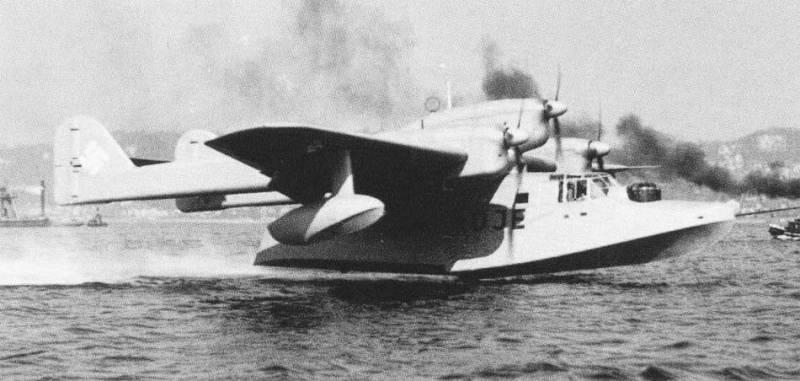
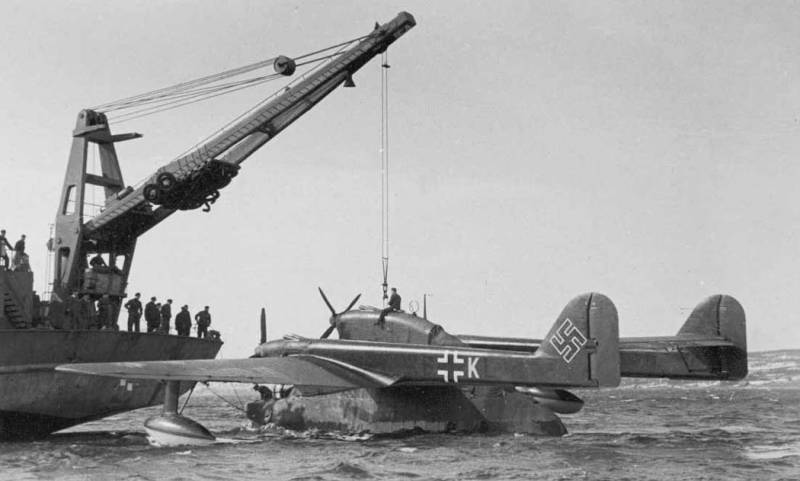
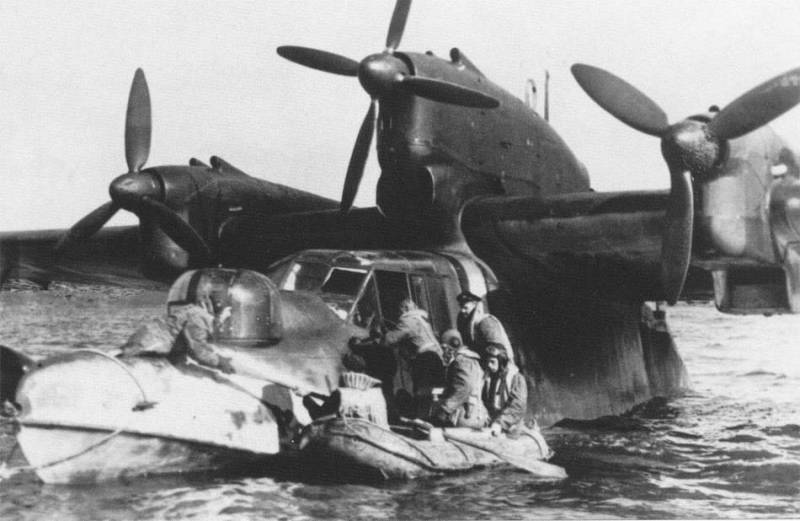
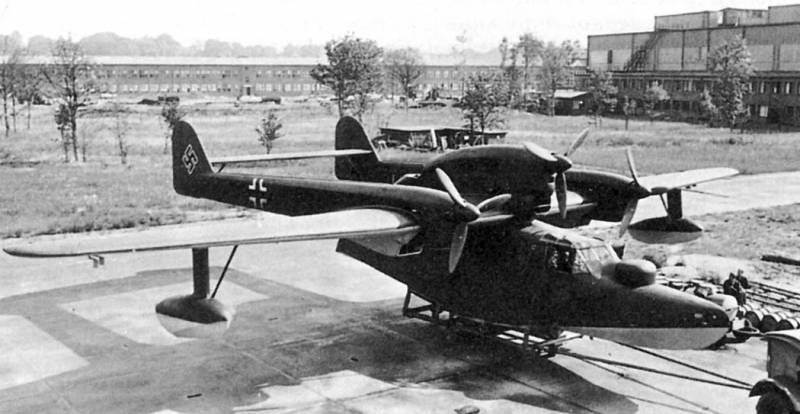
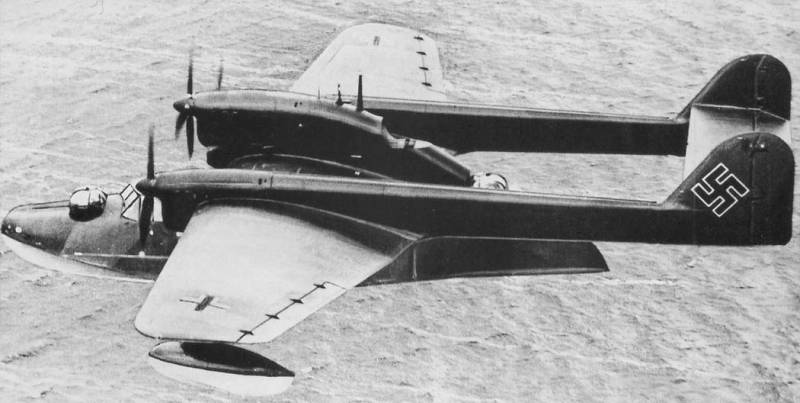
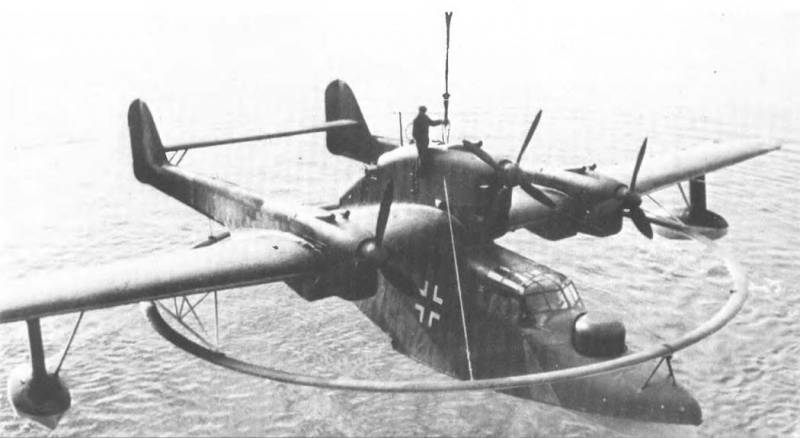
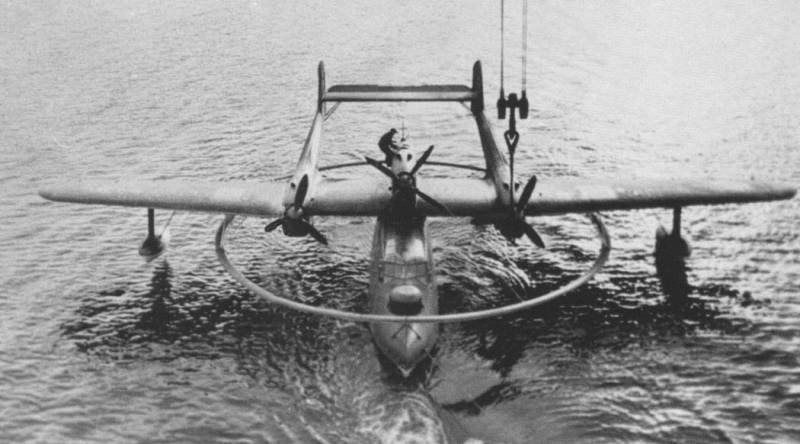
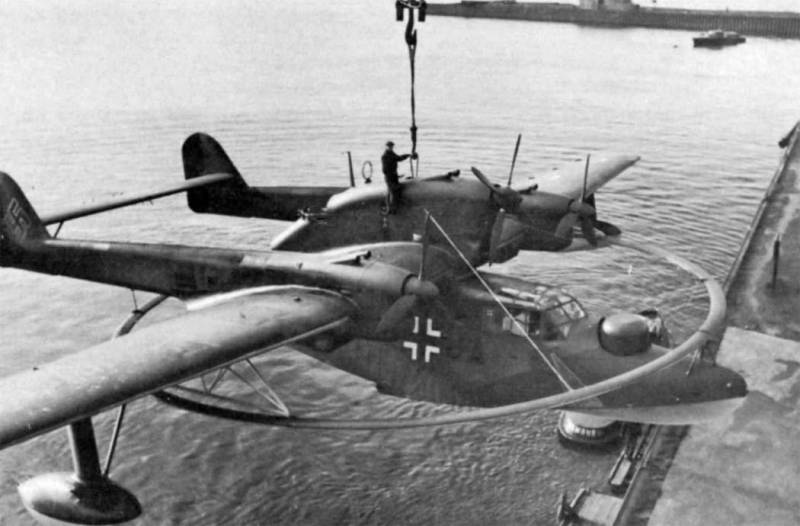
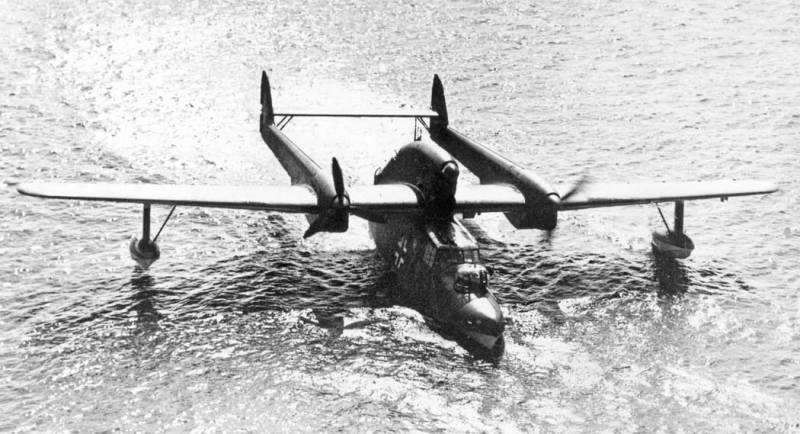
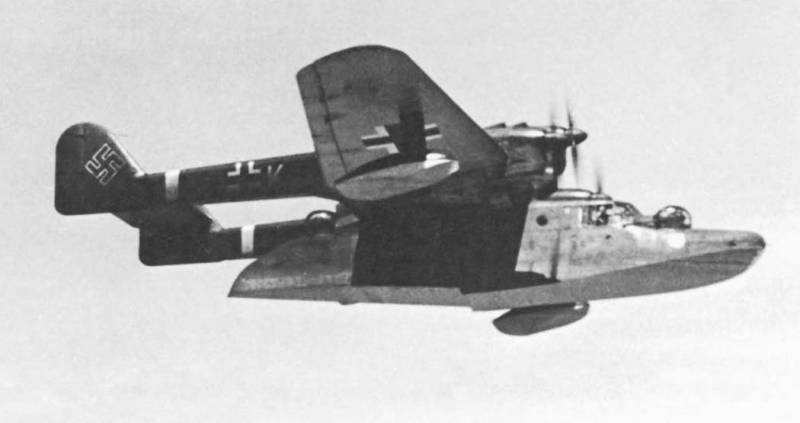
Information